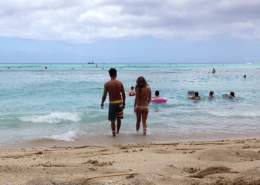The Best Time to Go Snorkeling: Seasonal Tips for Every Location
Snorkelling is a fantastic way to immerse yourself in the underwater world, whether you’re a seasoned ocean enthusiast or trying it for the first time. From vibrant coral reefs to playful marine creatures, every snorkelling experience is unique.
But when is the best time to snorkel in Australia, and how can you prepare for your adventure? This article discusses seasonal insights, snorkelling tips, essential gear, and safety tips.
Choosing the Best Time to Snorkel
Timing is crucial for an enjoyable snorkelling experience. The best time to snorkel depends on the season, water conditions, and location. Calm seas, warm water, and good visibility are ideal. For Australia, snorkelling is a year-round activity, but certain seasons offer better conditions for specific locations.
Snorkeling Conditions by Season
● Summer (December to February):
Summer brings warm waters and clear skies, perfect for snorkelling in tropical regions like the Great Barrier Reef. It’s also stinger season in northern Australia, so wearing stinger suits is essential for safety.
● Autumn (March to May):
Autumn offers excellent conditions in many areas, with fewer crowds and milder weather. The Gold Coast boasts calm seas, making it ideal for beginners.
● Winter (June to August):
Winter may be chilly, but it’s a fantastic time for snorkelling in southern locations like Jervis Bay, where visibility often peaks. The cooler months also bring humpback whale migrations, a stunning sight for snorkelers.
● Spring (September to November):
Spring combines warmer water temperatures with blooming marine life. Locations like Ningaloo Reef in Western Australia shine this season, offering encounters with whale sharks and vibrant coral reefs.
Best Times to Snorkel in Australia
Australia boasts a wealth of snorkelling destinations, each with its prime season:
- Great Barrier Reef: June to October offers the clearest visibility and calm seas.
- Ningaloo Reef: April to July is ideal for swimming alongside majestic whale sharks.
- Gold Coast: Year-round snorkelling opportunities with mild conditions and abundant marine life. Check out these snorkelling Gold Coast hotspots for a convenient underwater adventure.
Snorkelling Tips for Beginners
- Practice First: Start in a calm, shallow area to get comfortable with your gear.
- Stay Relaxed: Breathe slowly and evenly through your snorkel to avoid panic.
- Choose the Right Location: Beginners should choose sheltered areas with minimal waves, like Green Island in Queensland.
Refer to this first-time snorkeller guide, which covers everything you need to know before venturing into the water.
Snorkelling Gear Essentials
Your snorkelling experience hinges on having the right gear:
- Mask: Ensure a snug fit to prevent water leaks and fogging.
- Fins: Choose fins that fit comfortably and provide good propulsion.
- Safety Gear: A buoyancy vest is helpful for beginners or those snorkeling in deeper waters.
Investing in quality equipment enhances your safety and enjoyment.
Snorkeling Safety Tips
Safety is important for a novice or an experienced snorkeller. Here are some essentials:
- Check the Weather: Avoid snorkelling in rough seas or strong currents.
- Use Sunscreen: Choose reef-safe sunscreen to protect marine ecosystems.
- Stay Hydrated: Dehydration can lead to fatigue, so drink plenty of water.
- Buddy System: Never snorkel alone; always have a partner for added security.
These Snorkelling Safety Tips will help you navigate challenges and stay safe underwater.
Snorkelling Locations in Australia
Australia is a snorkeller’s paradise, offering diverse underwater landscapes and marine life:
- Whitsundays: Famous for its calm waters and vibrant coral gardens.
- Lord Howe Island: A UNESCO World Heritage site with crystal-clear waters and abundant marine life.
- Julian Rocks, Byron Bay: A hotspot for spotting turtles, rays, and tropical fish.
Explore these snorkelling locations in Australia to find a destination that matches your skill level and interests.
Marine Life to See While Snorkelling
Australia’s oceans are teeming with marine biodiversity:
- Tropical Fish: Angelfish, clownfish, and parrotfish are common in coral reefs.
- Turtles: Green and loggerhead turtles can be seen gliding gracefully through the water.
- Sharks: Reef sharks and whale sharks are non-threatening and awe-inspiring to observe.
- Coral Reefs: Vibrant coral formations create an underwater kaleidoscope of colour.
Researching the marine life to see while snorkelling at your chosen location adds an extra layer of excitement to your adventure.
Snorkelling Tips by Destination
- Gold Coast: Known for its accessible reefs and beginner-friendly spots, it’s a perfect location for those starting. Explore the best options for snorkelling in Gold Coast to find family-friendly sites.
- Cairns: Gateway to the Great Barrier Reef, Cairns offers tours tailored for every level of snorkeler.
- Rottnest Island: Snorkel alongside seals and tropical fish in Western Australia’s clear waters.
Snorkelling is more than only a fun activity—it’s a gateway to exploring the wonders of the underwater world. By understanding seasonal conditions, equipping yourself with the right gear, and prioritising snorkelling safety tips, you can make the most of your snorkelling adventure. Whether it’s your first time or your fiftieth, Australia’s diverse snorkelling spots offer something for everyone.
***
Jane Clark











